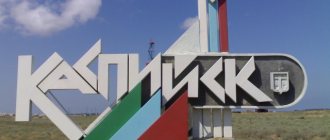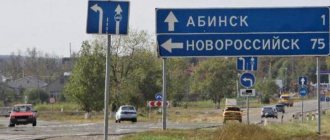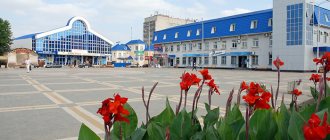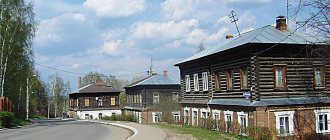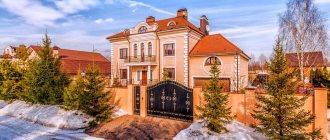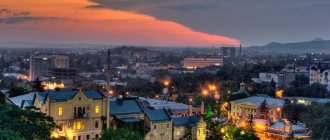Reading the reviews of those who moved to Stavropol, you are surprised at the inconsistency of those who wrote them. Most of them are positive. No less part contains both positive and negative aspects. There are also extremely negative ones. This is not surprising, since no two people have the same opinions. Reviews are needed for those who have chosen this city as their permanent place of residence. So what is it like - the center of the Stavropol Territory?
Geographical position
Negative reviews from those who moved to Stavropol often contain complaints about the city’s unfortunate location. It is located in the central part of the Ciscaucasia, on the hills and small mountains of the Stavropol Upland. Its elevations above sea level range from 230 to 660 meters. One of its streets is called “45th parallel” and runs exactly along it. If you look at a geographical map, you can see that it bisects the distance from the equator to the North Pole. The geographical location of the city is quite favorable.
Stavropol occupies a strategically important position - the watershed of the basins of two seas, the Azov and the Caspian. For this, the city was given the name “Gate of the Caucasus.” The urban area has an elongated position from southwest to northeast, its length is 24 kilometers. The peculiarity of the city is that the outskirts open onto forested areas. Some of them are part of the city in the form of parks. So if in the reviews of those who moved to Stavropol you see complaints about bad air in the city, don’t believe it. The foothills and natural forests make it clean and oxygenated.
Stavropol on the map of Russia - where it is located. Geography of the city
Stavropol on the map of Russia is located in the North Caucasus, in the southwestern part of the Stavropol Upland, on the banks of the Tashla River. The length of the city from southwest to northeast is 24 km, and from south to north – 16 km.
A peculiarity of the geographical location of Stavropol is its equidistance from the equator and the poles - the city stands on the 45th parallel.
Distance from Stavropol to major cities by road:
- Moscow – 1411 km north,
- Voronezh – 901 km north,
- Rostov-on-Don – 343 km northwest,
- Krasnodar – 299 km to the west,
- Sochi – 479 km to the southwest,
- Tbilisi – 574 km south,
- Mineralnye Vody - 165 km to the southeast,
- Volgograd – 569 km to the northeast.
The area around Stavropol is forest-steppe; in the west the city is closely adjacent to broad-leaved forests, where hornbeams, maples, ash trees, elms, and oaks grow.
The city's topography is hilly, with constant decreases and increases in altitude - from 230 to 660 meters above sea level.
The climate of Stavropol is temperate continental, with strong winds and an average annual temperature of +9.5 °C. Winter is mild and short (2.5 months), with frequent thaws, the average January temperature is -2.5 °C. Summer is hot, humid in the first half and long (up to 5 months), the average July temperature is +22 °C. There is approximately 560 mm of precipitation per year, the highest amount of which occurs in June (80 mm) and the least in February (28 mm).
Weather
The elevation of Stavropol above sea level determines frequent winds, the average speed of which is about 22 meters per second. Most often they blow in February-March. The predominant directions are western and eastern. In summer, the weather is dry and hot; in winter, frosty air comes from Kazakhstan and Siberia. Humid air masses come from the Atlantic, bringing heavy precipitation. In summer there are showers, and in winter there are snowfalls. Reviews from those who moved to Stavropol contain complaints about windy weather, but this is worth taking into account and accepting.
And yet Stavropol is a southern city. This is indicated by the number of sunny days per year. It is 160. The climate is temperate continental and is quite suitable for comfortable living. Here, thanks to the long growing season, a large number of fruits and vegetables ripen.
A little about the climate of Stavropol
It is a very green city due to the presence of many planted plants.
The climate of Stavropol is temperate continental. Summer is hot and winter is cold. Very often, the air temperature can change significantly throughout the day. This makes life here difficult for many weather-dependent people.
Average temperatures in January: from minus 9 degrees to minus 5 degrees, in July: from plus 22 degrees to plus 24 degrees.
Since the city is located in the steppe, it is characterized by strong winds, which in winter increase the feeling of cold. Five-degree frost can seem thirty degrees with a wind speed of 15-20 meters per second.
Ecology
Stavropol is the greenest city in Russia. There are many parks, squares and flowers. The city streets are decorated with a large number of flower beds and decorative plantings. This factor alone will make a person say: “I want to move to Stavropol.” The issue of clean environment is becoming a priority in the world. Not only the authorities, but also the population care about the ecology of the city. Along with existing programs to improve the environmental situation, great concern for the city lies with its residents. There are many front gardens with flowers around the houses. Caring people live here who oppose deforestation surrounding the city. According to a number of reviews from those who moved to Stavropol for permanent residence, the air here is much cleaner compared to the industrial centers of Russia.
In recent years, the environmental situation has noticeably deteriorated. This can be explained by the large number of cars and the presence of industrial enterprises. But everything possible is being done to make the city cleaner. Compared to other cities, the environmental situation in Stavropol is better. The nature of the city contributes to this. Frequent winds do not allow harmful emissions to stagnate. A large number of forests around the regional center ionize the air.
Where did the name of the city come from?
Those who have decided to move to Stavropol for permanent residence will be interested to know why the city received such a name. From Greek it is translated as “city of the cross.” There are several versions of its appearance. According to one of them, the name is associated with the plan of the fortress, which had the shape of a polygon, where its axes intersected at right angles and had the shape of a cross. The city of Stavropol was originally built as an outpost that was part of the Azov-Mozdok defense line, built by the Russian state to protect its territory from raids by nomads.
It is interesting that until 1964 in the Russian Empire, and subsequently in the Soviet Union, there were two cities with the same name. One is Stavropol-Caucasian, the other Stavropol is located in the Volga region. It was built as a fortress and later became known as Tolyatti. But there is another version, according to which the Cossacks, who began construction, found a stone cross here, after which they named the fortress.
Stavropol
Memorial of Eternal Glory
This memorial place is dedicated to the heroes of the Civil and Great Patriotic Wars.
The first face is the heroes of the Civil War, the second is the heroes of the Great Patriotic War, the third face, female, symbolic, is the face of the mother of the Motherland. The plaque is engraved: “The happiness won through the struggle of the people, through your life, is eternal.” There are always fresh and artificial flowers near the monument.
The memorial is located on Komsomolskaya Hill.
Monument Guardian Angel of the City
The 25-meter-tall monument was erected in honor of the 225th anniversary of the city. Now it is a symbol of the City of the Cross. This is a column lined with red granite, and at the very top there is a sculpture of an angel, raising the symbolic Cross above the city. There are fountains at the base of the monument.
The sculpture calls for the unification of citizens, and indeed all people. Once you look at the monument, you begin to talk about your purpose, your relationship with your loved ones and the good deeds you have done. The angel inspires and blesses. They also say that if you ask an Angel for something warm, kind and important, he will help bring the idea to life.
Cold spring
If you don’t know what to see in Stavropol, go to the cold spring. This is another memorial site of the city; the complex was erected as a tribute to those who died between 1930 and 1950. The memorial is located near the spring. A tradition has formed here: every May 8, students of the pedagogical institute gather at the memorial to offer flowers and honor the memory of the victims. The complex is located in a naturally colorful place, where you can relax in silence and solitude. Location - st. Lenin 397.
Fortress Mountain
There is a whole complex for urban recreation: monuments, attractions, architectural buildings. One of the main attractions of this place is the monument to Pushkin, not far from it is the Eternal Flame. There is also a Cathedral in the name of the Icon of the Mother of God. The very symbol of the city is located here - a cross in the center of the mountain. You can also go up to the observation deck - a panorama of Stavropol, the river and the Taman forest will open before you. By the way, a fragment of the Stavropol fortress wall, which was founded in 1777, remains here. Fragment 34 meters long.
Tiflis Gate (Triumphal Arch)
The structure is located at the beginning of Stavropol Boulevard. The arch was built in 1841. The building has been declared an architectural monument of antiquity.
Indigenous people
Stavropol was founded by the Cossacks. Most of the Russian population belongs to this class, which was formed in difficult conditions. The city was initially an outpost of Russia, guarding the borders and taking the first blows of the nomads. All this left an imprint on the traditions and customs of the Cossacks, on their character. Their main features are patience, a certain severity, and a careful attitude towards their identity, since without them it would be difficult to survive in difficult conditions. It is worth adding repression in the first years of Soviet power.
Today, Cossacks are difficult to distinguish among the mass of residents, but they remember their roots. In Stavropol, Cossack song competitions are held every year, in which folk groups from all over the region participate. Another public responsibility rests with them - together with the police, they maintain public order in the city.
Attractions
There are many places in Stavropol where you can spend your leisure time in a variety of ways, both for families with children and for young people.
Of greatest interest to tourists are:
- Art Museum
- Literary Museum
- Exhibition Hall of the Union of Artists of Russia
Locals love to walk in parks, of which Victory Park is the most popular. This place attracts parents with children, as it is famous for its various attractions.
Families with small children also love Central Park, where a petting zoo recently opened.
Alexander Square is also loved by both guests and the local population. There is a monument to the Guardian Angel here.
The recreation and entertainment complex “Gallery” is also located on the square. In which you can offer an interesting activity for children, and have a good rest yourself.
Among the clubs, the entertainment complex “New Rome” is especially popular.
There are also many restaurants, cafes and nightclubs in the city. So there is no time to be bored.
Knowing where Stavropol is located, you can safely go on a trip to see with your own eyes the beauty of the Stavropol region.
Population
In their reviews, those who moved for permanent residence to Stavropol sometimes complain that the local population is closed and not friendly. But you should always treat people the way you want them to treat you. Most of the visitors do not experience problems with the population. Life in the city is generally the same as in all provincial cities of Russia and the problems are the same. In recent years, migration has increased both from regions of Russia and the countries of the former CIS. Natural population growth prevails over mortality. This indicates a favorable social environment.
It should also be taken into account that Stavropol is located in the North Caucasus. Therefore, the influx of Karachais, Dagestanis, and Chechens has increased. People are looking for favorable living conditions, and if they come here from other regions, then the Stavropol Territory provides this. In terms of ethnic composition, more than 86% of Russians live in the city, followed by Armenians - 4.5%, Ukrainians, Karachais, Greeks and others - one percent each. The total number of inhabitants is 434 thousand.
Every year, flooded Stavropol attracts explorers of the depths. Both amateurs and professionals dive into it. Some want to “walk” along the ancient streets, others want to uncover forgotten pages of history. Our EPRON club has been setting this goal for itself for two decades now.
Initially, they dived to get an idea of the state of the bottom, former buildings, and to find evidence of that time. Current research is already more systematic. With the development of instrumental search, the collection of a large amount of information about the period of flooding and the transfer of the city, new research prospects are opening up, and therefore new discoveries.
Search engines discuss dive plan
What goals does the EPRON club set for itself?
Oddly enough, to this day the flooded city does not have a map. Moreover, we were unable to find an accurate topographical map linked to coordinates either in museum or town planning archives. There are a number of well-known sketches (not even maps), with schematic representations of streets and main buildings. But even today, it is impossible to calculate, with an accuracy of ten meters, where this or that building stood. It seems simpler - to find three, four, well-known places at the bottom and then, based on them, put the entire city on the map. But alas, from such places only two churches can be distinguished, which (like all other buildings) were destroyed and the rubble removed. The foundations are mostly covered with sand and silt, and based on the sparse foundations of the houses, it is not possible to determine their identity.
EPRON in 2016, for the first time, carried out a full-scale scanning of the bottom. The resulting picture shed some light on the state of the city’s remains, but did not provide all the answers. Since that time, the most characteristic objects have been investigated that could clarify the situation and identify several buildings, but except for the places where the Trinity Church was located, and a blacksmith shop with a market, and an oil depot (the western end of the city), nothing else could be established 100%.
A quarter-century of experience in identifying sunken objects has not brought any results. The city was completely relocated. Houses were demolished, all plantings were cut down, every little thing was transported to a new location, and unnecessary rubbish was dumped into wells and basements of houses. There were few stone houses and their foundations can still be found at the bottom, but finding them all is very difficult. At the site of flooding, there is a constant movement of huge masses of water, and, accordingly, sand and silt. What was discovered yesterday may today rest under a meter-long layer of sediment.
step into the unknown
It seems simpler - you stepped overboard, dived, examined the object, took a photo or video, and got the full picture. But no. Visibility under the most favorable conditions is no more than five meters. This means that even the scale of one room cannot be assessed, let alone the whole building.
There are not so many “transparent days” on the Volga. This is usually a period of two weeks at the junction of spring and summer. At this time, the weather and spring storms on the Kuibyshev Reservoir calm down a little. The turbidity settles, the flow (until the release of flood waters from the Volzhskaya HPP) slows down. But the water remains cold and you won’t spend much time at the bottom. Then the water is released, the current intensifies, and tons of sand and silt rise. Visibility becomes a few centimeters. There is no longer any question of any search.
Duty scuba diver Andrey Buzuev shares the results of the dive
And now, with the onset of warmth and a decrease in the speed of the current, fine days appear when there are no storms (and on the Volga there will be a storm more serious than a sea one). That's when we find the opportunity to explore the flooded city. But why not all summer? But because heat is as much an enemy of researchers as currents and storms. The Volga is blooming. It blooms in such a way that even on a bright sunny day, at a depth of ten meters it is as dark as a moonlit night. And the cost is incredible. By autumn, the flowering fades and the storms return, then the ice... Then everything repeats in a circle.
The EPRON club has plans for winter research, but it is very labor-intensive and expensive. There are no storms or currents, the water clarity is almost perfect, but you can only work from an ice hole. You can't do many dives in such conditions. After all, moving from one place to another takes a lot of time through ice and snow drifts. And organizing a new hole is not a matter of one hour. In addition, although there are no storms in winter, there is no windless weather on the open area of ice, where the width of the Volga reaches ten kilometers.
And despite all the problems, the search is ongoing. There is no way to dive - we scan the bottom. There is no opportunity to go out into the water area - we work with archives or in the club. The work is interesting and brings many new discoveries and impressions. Meetings with archivists and historians shed light on many facts that had not previously been published anywhere. New directions for studying the waters of not only the flooded Stavropol, but also other places that fell into the flood zone are emerging. There will be enough work for more than a dozen years. The main thing is that there are many like-minded people. And this cannot but rejoice.
Trinity Church of Stavropol
Now let's turn to the myths and misconceptions associated with the city resting under the water column. The most common myth is that the church still stands in its place and was even seen by people from the surface of the water.
This is a myth, or as they say now - a fake. With a bell tower height of about 30 meters, and even standing on a hill, it would be visible above the water. Here is a photo of the church after it was destroyed by an explosion.
Stavropol (on the Volga) church destroyed by explosion
Not only are there no piles of stones at the bottom, even the foundation of the temple (its fragment) was discovered quite recently. You can only find tree stumps. Diameter from half a meter to several centimeters. Everything was torn down to the ground.
Another common mistake, which is replicated by everyone, from museums to the press, is that the city area is almost regular, square in shape. And the fact that the city was located strictly along the cardinal points (as almost all cities are built now).
Schematic plan of Stavropol. Togliatti Museum of Local Lore
Stavropol stood along the Kunya Volozhka (a branch of the Volga). The angle relative to the cardinal points is from 100 to 120 degrees. Stretched along its shore. From west to east the length was four kilometers, and from south to north about a kilometer.
Aerial photography of Stavropol. 1953
In old photos, we often see only part of the city, which is photographed in such a way that it seems to be “elongated” from south to north. The streets ran at an angle relative to the cardinal points.
Stavropol (Samara).
This photo shows the real aspect ratio of the city, taking into account the fact that the right end is not included in the frame. You can understand how much is hidden based on the fact that the temple stood in the center of the city.
There is a misconception that during the spring release of water the Volga recedes and you can walk along the flooded streets of the city. This is easy to refute knowing that the water in the Kuibyshev reservoir rose by 27 meters. The city stood on a slight elevation above the water level, which means that at its deepest point it is now about 20 meters deep.
There are places that were not flooded - this is the current monastery, and at the time of the flooding the zemstvo hospital. The Stavropol cemetery (the site of the monument to Tatishchev) was partially flooded. But it was moved before the flooding. Not everything was moved, and excavations were carried out at this site in the 2000s. When the water recedes, you can see fragments of burials and even bones, but you need to approach this with restraint. It was impossible and not necessary to remove all the remains. And the fact that water sometimes washes away these fragments is simply a given that needs to be perceived adequately, without making a tragedy out of it and without making a “dance on the bones.”
Conventional map of Stavropol on the Volga. Author S. Dolgov
Historical reference.
Stavropol was founded as a city on the Volga in 1737. The place for the settlement was chosen by the famous scientist and statesman of that time, Vasily Tatishchev. It was proposed to name the city Epiphania, but Empress Anna was in favor of the City of the Cross (the meaning of the word Stavropol).
Initially, the city was built for Kalmyks, who by the mid-30s of the 18th century began to be introduced to Christianity. The highest decree was even issued on the separation of pagans from baptized Kalmyks. Stavropol was to become their capital. In 1754, 5.7 thousand people lived here, and in 1781 Stavropol became a district city.
And yet, in the end, nothing came of the experiment with the nomadic people, and in 1842 the Kalmyks, by order of Nicholas I, were resettled to Orenburg.
Unloading firewood on the Volga
By the end of the 19th century, Stavropol occupied a prominent place among the district cities in the Samara province. The Volga City of the Cross, among other things, was a climatic resort. Here they were treated for tuberculosis, including with kumiss.
Stavropol. City exchange of the early 20th century
The revolution and civil war broke the city's economy. Industry was destroyed, so in 1924 Stavropol degraded to the status of a village.
The main street of the city is Posadskaya (1914). After the revolution, it is Cooperative.
By the mid-1930s, the population of Stavropol was about 6 thousand people. Thanks to the discovery of oil on Zhiguli, the economy gradually revived. However, further development was prevented by the war. Stavropol on the Volga received the status of a city back in 1946, when 12 thousand people lived here.
Stavropol. State bank. Before the revolution, there was a grocery and haberdashery store belonging to the merchant Stolyarov.
Since 1950, it was Stavropol that became the headquarters of a project of epic scale - the creation of the Volzhskaya Hydroelectric Power Station.
Volzhskaya HPP named after Lenin at the construction stage
Since construction required flooding part of the city, it was decided to move Stavropol to a new, more elevated location.
Wooden houses in Stavropol were dismantled and moved to a new location, above the flood zone. Stone houses were blown up or dismantled into bricks. New Stavropol was already predominantly multi-storey.
Shock construction projects followed one after another; it was not easy to develop colossal spaces even within the framework of a planned economy.
However, this was no longer Stavropol.
In 1964, the leader of the Italian communists, Palmiro Togliatti, died. According to legend, the entire Soviet people grieved the loss. And at one of the rallies, the young worker Nikolai Garmash proposed renaming Stavropol to Tolyatti.
But this is a completely different story.
Districts of Stavropol
The administrative division of the city consists of three districts:
- Leninist. Located in the southeast.
- Industrial. Located in the west of the city.
- October. Center and northeastern part.
These are the official names of the districts. In ordinary life there is an informal division. Their residents gave them to certain territories and are known to almost all townspeople.
- Center. This is where most administrative and cultural institutions, large shopping centers, markets, and residential buildings are located.
- South. A residential area where everything you need for living in high-rise buildings is located, kindergartens, schools, hospitals, shops, markets. Located in the southwest.
- North. A residential area in the northwest. Smaller than the South.
- Tashla. The area along the Tashla River.
- Mamaika. Houses on Yuzhnaya and Gornaya streets, located along the river of the same name.
- 204 quarter. The lower part of Serova street and st. Dostoevsky. Here are houses built for the military.
- Tuapsinka. The lower parts of Lenin and Mira streets, as well as part of Obezdnaya.
- Ossetian. Part of the street Lenin.
- Botany. The area around the botanical garden located on the street. Lenin.
- Barracks. Crossing the street Tolstoy and Shpakovskaya.
Real estate
Most of the private houses are located in the areas of Mamayki, Tashly, and Baraki. But recently there has been construction of five-story buildings along Tashly. Private houses can also be found in residential neighborhoods. The bottom of the Center is private buildings, the top is an area of elite multi-storey buildings. In the city you can buy housing for any budget; its cost ranges from 500 thousand to tens of millions of rubles. As reviews from those who moved show, life in Stavropol, the quality of housing depends on the level of income.
The cost of real estate in Stavropol, as in other cities, depends on many factors - the area of the city, the number of square meters, the availability of amenities, the time of construction. Housing prices are not much different from other industrial cities.
Transport
You can get to the city by rail, road, or plane. It should be immediately noted that planes fly from the airport only to Moscow and Yerevan. From the Stavropol-Rostov railway station you can go to almost any city in the country. Today this is the most accessible type of intercity passenger transportation.
Two federal highways P269 to Bataysk and P216 through Elista to Astrakhan go through the city. Intercity flights depart from the Central Bus Station to many cities in Russia. By buses traveling from bus station No. 1, you can get to the resorts of the Stavropol Territory and other regional centers of the country. Buses depart from bus station No. 2 to cities and remote villages of Stavropol. Suburban settlements are accessible from the bus station.
There is public transport throughout the city - buses, trolleybuses, minibuses and taxis. The construction of tram lines is planned. According to reviews from those who moved, there are a lot of traffic jams on the streets. In recent years, the number of private cars has increased sharply. This has led to traffic jams forming on the roadway during rush hour. But which city doesn't have them? Whether it is worth moving to Stavropol for permanent residence is something everyone decides for themselves. Traffic jams in the city cannot be a reason that will become an obstacle to moving, since this is a problem in all cities of the world.
Map of the city of Stavropol with roads. Transport of Stavropol
Stavropol is the transport “gate” of the Caucasus. The federal highway P216 Stavropol - Elista - Astrakhan and the regional highways P267 Stavropol - Shpakovskoye Airport, P269 Stavropol - Bataysk pass through the city.
There is 1 bus station and 3 bus stations in the city. From the Central Bus Station, located on Marshal Zhukov Street, 27, regular buses depart to St. Petersburg, Adler, Astrakhan, Volgograd, Vladikavkaz, Krasnodar, Sochi, Baku and dozens of other settlements.
Trains run at the Stavropol railway station in the directions Stavropol - Adler, Palagiada - Stavropol, Kavkazskaya - Stavropol. On the map of Stavropol with streets, the station is located on Vokzalnaya Street, 17.
Stavropol International Airport is located 14 km northeast of the city center. From there there are flights to Moscow, St. Petersburg and Rostov-on-Don.
60 bus and minibus routes, as well as 9 trolleybus routes are available to residents. The fare for buses is 21 rubles, for minibuses – 23 rubles, for trolleybuses – 18 rubles.
Job
There are many enterprises of different directions here that produce radio-electronic equipment, auto parts, transformers, metal-plastic windows, cosmetics, plumbing fixtures, furniture, and honey. drugs, food. There are oil and gas industry enterprises. According to statistics, the volume of goods produced is growing.
This suggests that industrial and food enterprises are developing. To move to Stavropol, you need to be sure that you can find a job here with a decent salary. It does not exceed the national average, excluding the two capitals. The city is experiencing the same problems as any other in Russia.
Education
There are 48 educational institutions in Stavropol, including 7 lyceums and 4 gymnasiums. The city has 57 municipal and 12 private kindergartens, nine state higher educational institutions, 11 secondary specialized and 27 additional education organizations, five orphanages.
Recently, the number of babies born has increased, so it is not always possible to place a child in a public kindergarten near home. But over time, people find a way out of this situation. In Stavropol you can get higher education in almost any specialty.
Medical service
Negative reviews from those who moved to the city of Stavropol talk about poor medical care. This is a problem for the whole country; there are problems with the quality of medicine in every city in Russia. The city employs doctors who were educated in their medical field. Academy that graduates doctors of various profiles. There are 20 medical institutions, which is a lot for the relatively small Stavropol.

